Specify Building Types
Building Types are used to represent buildings, parks, and other elements in terms of their detailed built form characteristics. They are defined as a composite of one or more Components. Building Types are used in painting scenarios, while Components can only be used as ingredients for Building Types.
This article steps through the specifications required to define a Building Type, and their resulting characteristics. It is organized according to the layout of the Manage > Building Types screen, which echoes that of the Components screen but with sections that show the characteristics resulting from the mix of Components as read-only values, rather than inputs.
Building Type Summary
The Building Type Summary panel contains a summary of basic built form characteristics. The panel can be used to easily compare Building Types as you browse your library. All attributes are calculated by the model.
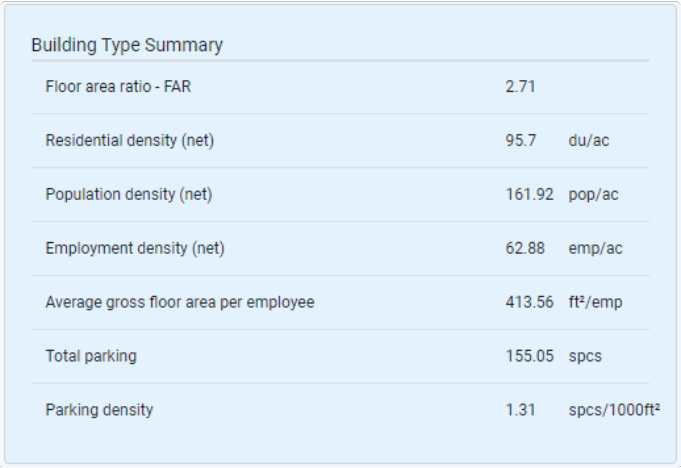 |
Building Type Summary panel
Floor area ratio - FAR – Floor area ratio (FAR) refers to the ratio of total gross building floor area to parcel area. Total gross building floor area for a Building Type is based on floor area as specified for the included Components. Values for the floor area of individual Components are all normalized to one net acre, and weighted according to their percentage allocation within the Building Type.
Residential density (net) – Net residential density refers to the number of dwelling units per acre of parcel area. Residential density for a Building Type is calculated as the weighted total of the densities of the included Components. Densities are weighted according to the percentage allocation of Components within the Building Type.
Population density (net) – Net population density refers to the number of residents per acre of parcel area. Population density for a Building Type is calculated as the weighted total of the densities of the included Components. Densities are weighted according to the percentage allocation of Components within the Building Type.
Changing the variable assumptions for residential occupancy rate and household size(s) by housing type, as set on the Library Settings page, will change population density. See Use Library Settings for information on managing these settings.
Employment density (net) – Net employment density refers to the number of jobs per acre of parcel area. Employment density for a Building Type is calculated as the weighted total of the densities of the included Components. Densities are weighted according to the percentage allocation of Components within the Building Type.
Changing the variable assumptions for non-residential building occupancy rate and gross floor area per employee by employment sector, as set on the Library Settings page, will change employment density. See Use Library Settings for information on managing these settings.
Average gross floor area per employee – Average gross floor area per employee for a Building Type is calculated based on the gross occupied non-residential floor area and jobs in the included Components. Changing the variable assumptions for non-residential building occupancy rate and gross floor area per employee by employment sector, as set on the Library Settings page, will change the average gross area per employee. See Use Library Settings for information on managing the underlying settings.
Total parking – Total parking is calculated as the sum total of parking by type (including surface, structured, and internal/underground) as specified for the component.
Parking density – Parking density refers to the total number of parking spaces (of all types) per thousand square feet of total gross building floor area. Parking density for a Building Type is calculated as the weighted total of the densities of the included Components. Densities are weighted according to the percentage allocation of Components within the Building Type.
Building Type Information
The Building Type Information panel contains basic information for identifying and categorizing the Building Type.
 |
Building Type Information panel
Building Type Name – The Building Type Name as entered here appears in the Building Type Library list at the left of the screen.
Building Type Identifier – A colored square containing the initials of the Building Type name, used as quick identifier here and in the Build Scenario > Building Types menu. A default color is selected based on land use category. Click on the chip to change the color.
Land Use Category – Refers to the Land Use Category (L3) designation. Select the L3 category that the Building Type should be associated with. The L2 and L1 level designations are automatically designated on the basis of L3. (See Land Use Hierarchy for more information.)
Description – A description of the Building Type. This field is optional.
Place Types – A list of the Place Types in which the Building Type is included. The list is automatically generated. Clicking on a Place Type name brings up the Manage screen for the Place Type.
Components by Land Area
The built form characteristics of a Building Type are derived from the mix of Components specified in this panel.
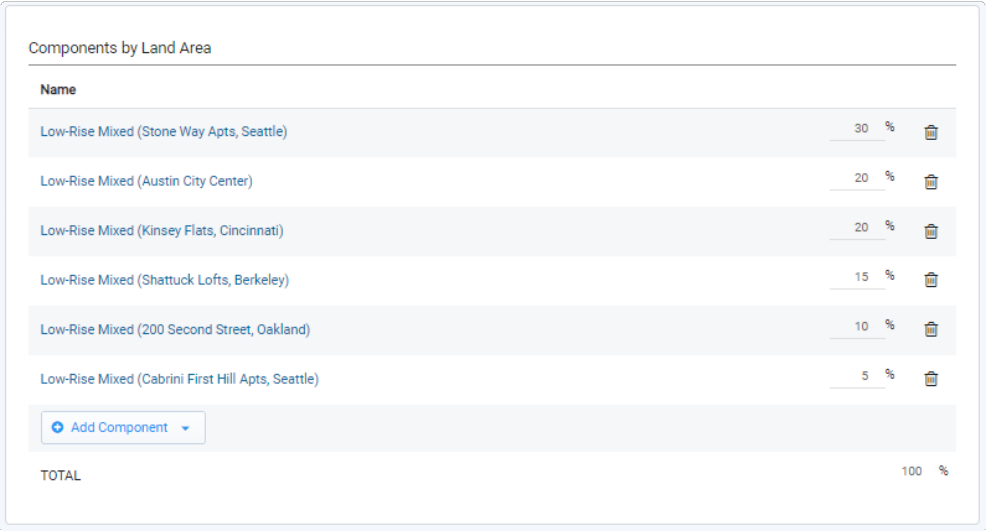 |
Component distribution within a Building Type
Add Component – To add a Component to the Building Type, click + Add component. This brings up a searchable list of Components to choose from. Once you select a Component, it is added to the Components by Land Area list.
Component percentage – The share of the Building Type represented by the Component, in terms of land area. The percentages must total to 100%.
Area Coverage (Building Types)
The Area Coverage panel provides a summary of how the land area of a Building Type is distributed. The information, all of which is read-only, includes the amount of land area per acre of each type of coverage, and its share of the total. The chart illustrates the distribution of coverage.
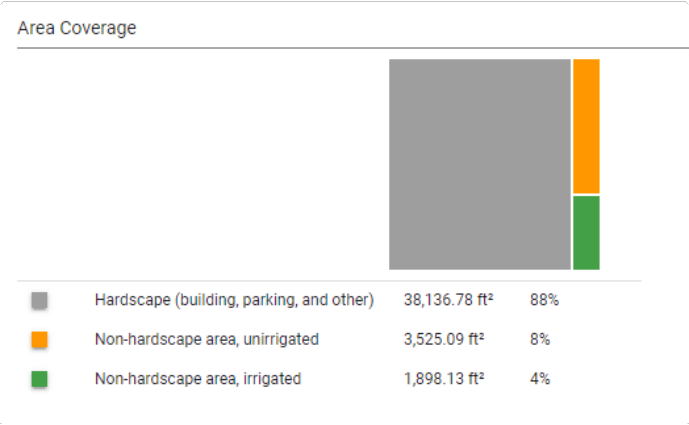 |
Area Coverage panel
The coverage categories include:
Hardscape – This includes building footprint area, structured parking footprint area, surface parking area, and "other hardscape" area as specified for Components. The area per acre by Building Type is calculated as a weighted total of the included Component areas.
Non-hardscape area, unirrigated – This area is a product of non-hardscape area and irrigated/non- irrigated percentage. The area per acre by Building Type is calculated as a weighted total of the included Component areas.
Non-hardscape area, irrigated – This area is a product of non-hardscape area and irrigated/non-irrigated percentage. The area per acre by Building Type is calculated as a weighted total of the included Component areas.
Site Coverage (Building Types)
The Site Coverage section of the Site Characteristics panel describes how the land area of a Building Type is distributed. The values for each type of coverage are expressed as percentages, and are calculated based on the distribution of the included Components.
 |
Site Coverage section of Site Characteristics panel
Total parcel area – The area of the parcel or site. Components are assumed to represent development over parcel or "net" land area only—that is, area not inclusive of rights-of-way or other infrastructure components.
Building footprint – The land area covered by the ground floor of the building, expressed as a percentage of total parcel area.
Structured parking – The land area covered by any dedicated parking structures on site, expressed as a percentage of total parcel area. This does not include area attributed to internal or underground parking, which by definition fall within the building footprint.
Surface parking – The land area covered by surface parking, expressed as a percentage of total parcel area.
Other hardscape – The land area covered by walkways, patios, and any other type of impermeable hardscape, expressed as a percentage of total parcel area.
Non-hardscape – The land area not covered by hardscape, expressed as a percentage of total parcel area. This can include landscaped areas, bare land, or any other permeable area.
Irrigated / Non-irrigated – The percentage of non-hardscape area that is assumed to be irrigated or not.
Parking (Building Types)
The Parking section of the Site Characteristics panel describes the amounts of parking by type included in the Building Type. Values for each type of parking are shown in spaces per acre, and are calculated based on the distribution of the included Components.
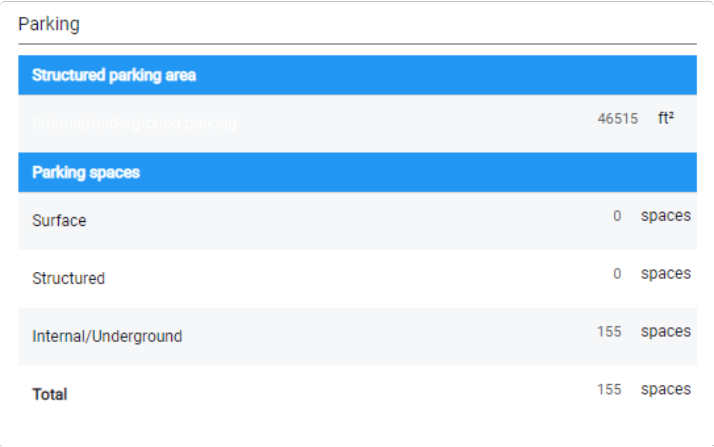 |
Parking section of Site Characteristics panel
Internal/structured parking – The total area dedicated to internal or underground parking, which is defined as parking that is located in garages within the structure of a building. This area is not accounted for as building area.
Surface parking spaces – The number of surface parking spaces.
Structured parking spaces – The number of parking spaces in standalone structured parking garages.
Internal/Underground parking spaces – The number of internal or underground parking spaces, which is defined as those located in garages within the structure of a building.
Building Characteristics and Building Envelope
The Building Characteristics panel describes building floor area and how it is distributed, along with building envelope characteristics. The values are calculated based on the distribution of the included Components. Since a Building Type may be defined as a composite of multiple individual prototype buildings, the characteristics should be seen as averages rather than representative of a single building. (For example, a Building Type defined as 50% of four-story buildings and 50% of five-story buildings will have an average of 4.5 floors.)
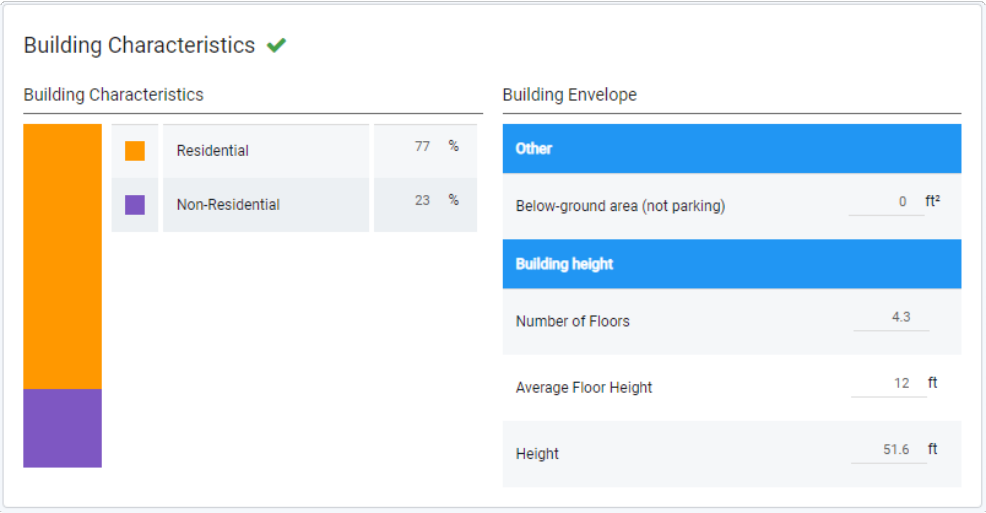 |
Building Characteristics and Building Envelope sections of Building Characteristics panel
Residential – The amount of gross floor area dedicated to residential uses, expressed as a percentage of total floor area.
Non-Residential – The amount of gross floor area dedicated to non-residential uses, expressed as a percentage of total floor area.
Below-ground area (not parking) – The amount of area dedicated to basements and other below-ground space, and not used for parking. This value is informational and not associated with the values for gross floor area.
Number of floors – The average number of floors or stories in the included buildings. The number of floors is not associated with values for building square footage, site coverage, or FAR.
Average Floor Height – Average floor-to-floor height for the included buildings. Average floor height is not associated with values for building square footage, site coverage, or FAR.
Height – The average height of the included buildings. Building height is not associated with values for building square footage, site coverage, or FAR.
Residential Floor Area Allocation (Building Types)
The Residential portion of the Floor Area Allocation panel summarizes the number of dwelling units and average unit sizes by housing type. The values are calculated based on the housing distribution of the included Components.
 |
Floor Area Allocation panel
Average unit size – The average unit size per dwelling unit, expressed in terms of net residential floor area.
Distribution by dwelling unit type – Information for each dwelling unit type include number of units per acre, and average unit size.
Single-family large lot – Analyst defines large lot homes as those with lot sizes of 5,500 sq ft and above. The distinction between large and small lot single family homes supports the use of differentiated assumptions for household size, as well as analysis assumptions for energy and water use.
Single-family small lot – Analyst defines small lot homes as those with lot sizes under 5,500 sq ft. The distinction between large and small lot single family homes supports the use of differentiated assumptions for household size, as well as analysis assumptions for energy and water use.
Single-family attached – Includes townhomes, rowhomes, duplexes, and other single-family home types with shared walls.
Multifamily – Refers to housing in which multiple units are contained within a single building or group of buildings.
Accessory – Refers to a secondary dwelling unit on a lot occupied by a primary dwelling unit (typically a single-family home).
Non-Residential Floor Area Allocation (Building Types)
The Non-Residential portion of the Floor Area Allocation panel summarizes the employment mix that results from the distribution of non-residential building area among employment uses. Employment is represented by six top-level sectors and a number of sub-sectors that nest into them. Employment density at the Component level is determined by the floor area allocations, along with assumptions for the distribution of employment by subsector, floor area per employee, and non-residential building occupancy. The densities for Building Types are calculated based on the employment area characteristics of the included Components.
Changing the variable assumptions for non-residential occupancy rate and floor area per employee by sector and building density category, as set on the Library Settings page, will change the employment densities. See Use Library Settings for information on managing these settings.
 |
Floor Area Allocation panel
Average gross floor area per employee – Calculated based on the gross occupied non-residential floor area and jobs in the included Components. Changing the variable assumptions for non-residential building occupancy rate and gross floor area per employee by employment sector, as set on the Library Settings page, will change the average gross area per employee. See Use Library Settings for information on managing the underlying settings.
Distribution by employment sector – Summarizes the employment mix for the Building Type in terms of the density and share of employees in each of the six top-level sectors. Job densities are determined by specifications made at the Component level for how non-residential floor area is distributed, and variable assumptions for floor area per employee. For more information, see Non-Residential Floor Area Allocation for Components.
Employment mix and densities cannot be set directly. At the Building Type level, you can tune employment densities by adjusting the mix of Components included. These specifications are required to support robust planning and analysis that account for employment by type, and the impacts of different uses on building energy use, water use, carbon emissions, and more.
Each sector row contains a value for employment density and the percentage of employees in that sector. Clicking the Edit button  allows you to view the further distribution of employment into subsectors. The employment sectors and subsectors are listed below:
allows you to view the further distribution of employment into subsectors. The employment sectors and subsectors are listed below:
Retail – Includes Retail Services, Restaurant, Arts & Entertainment, Accommodation, and Other Services.
Office – Includes Office Services and Medical Services.
Public – Includes Public Administration and Education Services.
Industrial – Includes Manufacturing, Wholesale, Transportation & Warehousing, Construction, and Utilities.
Agriculture – Includes Agriculture and Extraction.
Military – Includes Military only.
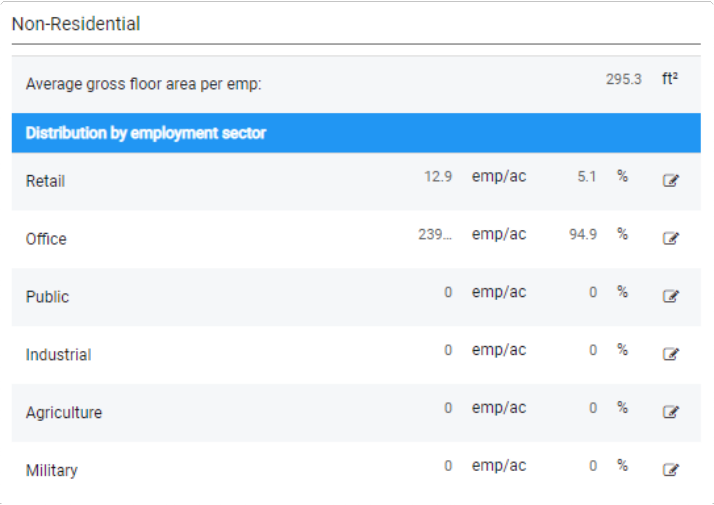 |
Distribution of employees by employment sector
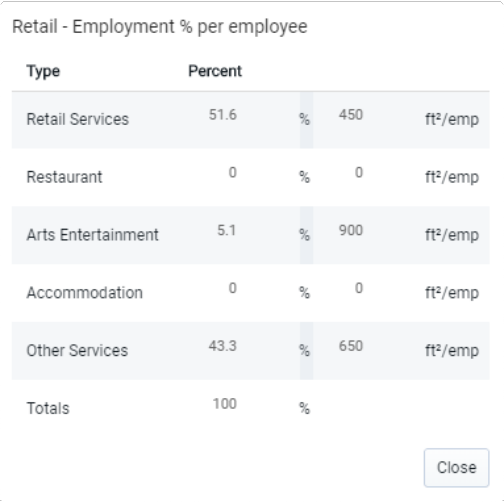 |
Distribution of employees by employment subsector